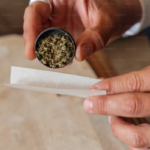
I’ve been a pharmacist for over a decade, and one question I hear surprisingly often is whether someone can get high just from smelling marijuana. It’s a valid concern, maybe you’re worried about exposure at a concert, or perhaps your roommate smokes and you’re wondering if those wafting odors might affect you.
Let me cut to the chase: while it’s technically possible to experience effects from secondhand marijuana smoke, getting significantly high from simply smelling weed in passing is highly unlikely. But there’s more to the story, and the details matter.
The Science Behind a “Contact High”
First, let’s talk about what’s actually happening when someone gets high. THC (tetrahydrocannabinol) is the main psychoactive compound in cannabis that produces the euphoric effects. When someone smokes marijuana, THC enters the bloodstream through the lungs and eventually reaches the brain.
For secondhand exposure, the amount of THC you might inhale depends on several critical factors:
- Ventilation: A closed car versus an open-air concert
- Proximity: Sitting next to someone smoking versus being across the room
- Potency: High-THC cannabis produces stronger secondhand effects
- Duration: Brief exposure versus hours in a smoky environment
I remember consulting with a patient who was concerned about failing a drug test after attending a concert where people were smoking. I explained that in well-ventilated spaces with casual exposure, significant effects are rare. Research backs this up. A 2010 study published in the Journal of Analytical Toxicology found that non-smoking participants in a Dutch coffee shop showed only trace amounts of THC, not enough for a high or a positive drug test.
When a Contact High Is More Likely
That said, I’ve seen cases where secondhand exposure did produce noticeable effects. The classic scenario? “Hotboxing,” when people smoke in an enclosed space like a car or small bathroom with poor ventilation.
In these conditions, non-smokers can inhale enough THC to experience mild effects. There was once a college student come to me worried after feeling dizzy and hungry after sitting in his friend’s car while they smoked. This makes sense, in confined spaces, THC concentrations can build up significantly.
The research confirms this too. A landmark 2015 Johns Hopkins study published in Drug and Alcohol Dependence showed that non-smokers placed in an unventilated room with people smoking high-potency marijuana reported feeling “pleasant,” had mild impairment on performance tests, and some even tested positive for THC in urine tests. When the same experiment was conducted with ventilation, effects were drastically reduced.
Beyond the High: Other Effects of Secondhand Smoke
Even if you don’t get high, secondhand marijuana smoke can cause other unwanted effects:
- Red or irritated eyes
- Coughing or throat irritation
- Headaches
- Mild nausea
- Dizziness
These symptoms are more common than an actual high and can affect sensitive individuals even with brief exposure.
Will Secondhand Marijuana Smoke Show Up on a Drug Test?
This is probably the most common concern I hear in my practice. The short answer: it’s possible but unlikely in most casual exposure scenarios.
Standard drug tests are designed with cutoff levels to prevent positive results from passive exposure. However, if you’re in an unventilated space with heavy marijuana smoke for hours, there is a small risk of testing positive.
The previously mentioned Johns Hopkins study found that non-smokers exposed to heavy marijuana smoke in unventilated conditions did occasionally exceed the standard 50 ng/mL THC metabolite cutoff for drug testing. However, those in ventilated rooms generally remained below detection thresholds.
For anyone with an upcoming drug test, it’s smart to play it safe and avoid significant exposure altogether. I heard about someone who turned down a ride with friends who were smoking in the car right before a pre-employment screening. Probably a wise call. Even secondhand exposure can raise unnecessary risks when the stakes are high.
Health Risks: Is Secondhand Marijuana Smoke Harmful?
As a pharmacist, I need to address the specific health risks beyond just the “high.” While the research on secondhand marijuana smoke isn’t as extensive as tobacco research, recent studies have identified several concerning health impacts:
Respiratory Effects:
- Irritation of airways and lungs
- Potential for bronchitis-like symptoms with regular exposure
- Increased phlegm production and chronic cough
- Potential for reduced lung function with long-term exposure
Cardiovascular Effects:
- A 2016 study in the Journal of the American Heart Association found that secondhand marijuana smoke impaired blood vessel function in rats for about 90 minutes, compared to 30 minutes with tobacco smoke.
- Potential for increased heart rate and blood pressure
- Possible heightened risk for individuals with pre-existing heart conditions
Carcinogenic Potential:
- Marijuana smoke contains many of the same carcinogens as tobacco smoke, including polycyclic aromatic hydrocarbons and nitrosamines.
- A study by the California Environmental Protection Agency found that marijuana smoke contains 33 known carcinogens.
For people with asthma or other respiratory conditions, exposure can trigger symptoms or exacerbate existing issues. Some patients with asthma report increased use of rescue inhalers after being around marijuana smoke.
Special Concerns for Vulnerable Groups
The risks are significantly higher for certain populations:
Children
Children’s developing brains are particularly vulnerable to cannabinoids. A 2018 study in Pediatrics found THC metabolites in the urine of children exposed to secondhand marijuana smoke, indicating systemic absorption of these compounds.
Research suggests exposure may affect brain development, potentially impacting:
- Memory formation
- Attention span
- Problem-solving abilities
- Overall cognitive development
As a healthcare professional, I strongly recommend treating marijuana smoke like tobacco smoke, keep it away from children completely.
Pregnant Individuals
If you’re pregnant, avoid secondhand marijuana smoke entirely. A 2020 review in the Journal of the American Medical Association found potential links between maternal cannabis exposure and:
- Lower birth weight
- Preterm birth
- Developmental issues
- Potential impacts on fetal brain development
People with Respiratory Conditions
Individuals with asthma, COPD, or other respiratory conditions may experience:
- Increased frequency of asthma attacks
- Worsened symptoms
- Greater need for medication
- Higher risk of respiratory infections
People with Cardiovascular Issues
The temporary effects on blood vessels and heart rate could pose risks for those with:
- Hypertension
- History of heart attack or stroke
- Arrhythmias
- Coronary artery disease
Comparing Secondhand Marijuana and Tobacco Smoke
While people often perceive marijuana smoke as “less harmful” than tobacco smoke, research suggests important similarities:
- Both contain particulate matter that can irritate the lungs
- Both contain similar levels of toxic compounds like ammonia and hydrogen cyanide
- Both can impair blood vessel function, with marijuana’s effects potentially lasting longer
- Both contain tar and carcinogenic compounds, though in different proportions
The key difference is that marijuana smoke contains cannabinoids like THC, while tobacco smoke contains nicotine. However, from a respiratory health perspective, the physical irritation and potential harm share many similarities.
Practical Tips to Minimize Exposure
If you’re concerned about secondhand marijuana smoke, here are some practical steps I recommend:
- Improve ventilation: Open windows, use fans, or move to outdoor areas when possible.
- Create distance: The further you are from the source, the less you’ll be exposed.
- Limit time: Brief exposure is less likely to cause effects than prolonged exposure.
- Communicate boundaries: Don’t be afraid to express concerns about smoke exposure, especially if you have health conditions or upcoming drug tests.
- Consider air purifiers: HEPA filters can help reduce particulate matter in shared living spaces.
The Bottom Line
Based on both the research and my clinical experience, getting significantly high from simply smelling marijuana in passing is highly unlikely. However, prolonged exposure in poorly ventilated spaces can lead to mild effects and potentially detectable levels of THC.
The health risks of secondhand marijuana smoke appear similar to those of tobacco smoke, with potential impacts on respiratory, cardiovascular, and overall health. Vulnerable populations including children, pregnant individuals, and those with pre-existing health conditions should be particularly cautious about exposure.
If you’re concerned about exposure, your best bet is to treat marijuana smoke like any other smoke. Minimize exposure through ventilation, distance, and limiting time in smoky environments.
And remember, if you have specific concerns about how secondhand marijuana smoke might affect your health or medication regimen, talk to your healthcare provider. We’re here to help navigate these questions without judgment.





